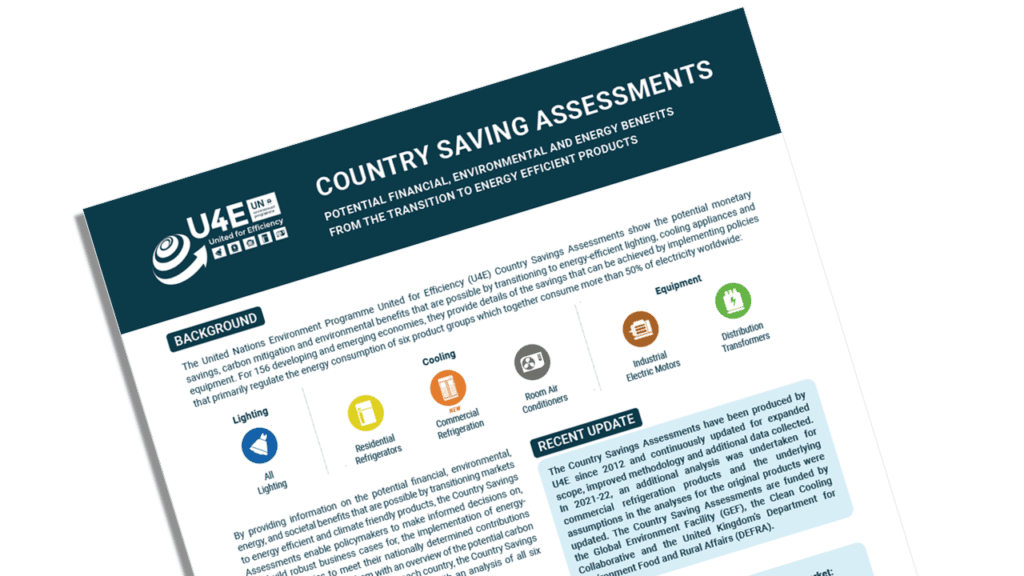New United Nations Environment Programme United for Efficiency (UNEP-U4E) analysis estimates that, if all developing and emerging economies adopted minimum energy performance standards (MEPS) for six key product areas, over 910 TWh of electricity consumption could be saved annually in 2040, equivalent to 416 large power stations or more than the total current consumption of Türkiye, Indonesia and South Africa combined. The associated climate benefits include mitigating 820 million tonnes of CO2 annually and a USD 130 billion saving for consumers on their electricity bills annually.
The assessments compare a business-as-usual scenario with a minimum ambition scenario, in which policies are introduced in line with the basic requirements of the UNEP-U4E Model Regulation Guidelines, and a high ambition scenario in which more stringent policies are implemented in line with the highest levels proposed in the guidelines. The annual global savings potential in 2040 rises from 910 TWh based on the minimum ambition scenario to 1,900 TWh based on the high ambition scenario.
By providing information on the benefits that are possible by transitioning national markets to energy efficient and climate friendly products, the country savings assessments enable policymakers to make informed decisions on, and build robust business cases for, the implementation of energy-efficiency policies to meet their nationally determined contributions (NDCs) whilst providing them an overview of potential carbon emissions that could be offset.
This analysis reveals that electricity consumption for commercial refrigeration could increase by over 39% by 2040 as more products are used. However, policies in line with the basic requirements of the UNEP-U4E model regulation guidelines for commercial refrigeration equipment could reduce this increase to as little as 13%. More stringent policies, in line with the highest levels proposed in the guidelines, could decrease future consumption to below current levels.
Based on the more conservative scenario, annual electricity savings for commercial refrigeration could reach over 66 TWh in 2040. This is equivalent to avoiding the construction of 30 large [500 MW] power plants and would reduce CO2 emissions by 64 million tonnes annually, saving consumers $9.5 billion on their electricity bills.
In the context of cooling as a whole (domestic and commercial refrigeration and room air conditioners), global demand is projected to grow to 3.6 PWh by 2040 in the absence of energy efficiency policy intervention (an increase of 68% against the current level of 2.2 PWh). The analysis further predicts that over 70% of electricity savings and carbon mitigation can be attributed to implementing MEPS in the cooling domain.
For lighting, LED lamps are an energy efficiency success story, with existing technologies and policies already significantly transforming markets to reduce energy consumption. In fact, the analysis reveals that global electricity consumption for lighting could decrease by 4% by 2030. More stringent policies could reduce this to 17% below current levels and complementary controls such as occupancy and daylight sensors could decrease this even further.
For equipment, the updated analysis estimates that annual electricity savings for motors could reach almost 187 TWh in 2040, with associated CO2 savings of 185 million tonnes and a financial saving of $26 billion for consumers on their electricity bills. The use of variable speed drives in all suitable applications could further increase this saving. For distribution transformers it predicts annual electricity savings of 55 TWh by 2040, with associated CO2 savings of 45 million tonnes and a financial saving of $7 billion for consumers on their electricity bills. The main additional savings opportunities for distribution transformers come from optimising management practices.
More detailed information on the country savings assessments, and the assumptions on which they are based, can be found in the UNEP-U4E Country Savings Assessments Factsheet and UNEP-U4E Country Savings Assessments Methodology and Assumptions summary.
The country savings assessments for each country, along with separate online analyses for cooling (residential refrigerators, commercial refrigeration and room air conditioners), lighting (in the residential, commercial and outdoor sectors) and equipment (industrial electric motors and power distribution transformers), are available on the Country Savings Assessment pages of the website.
